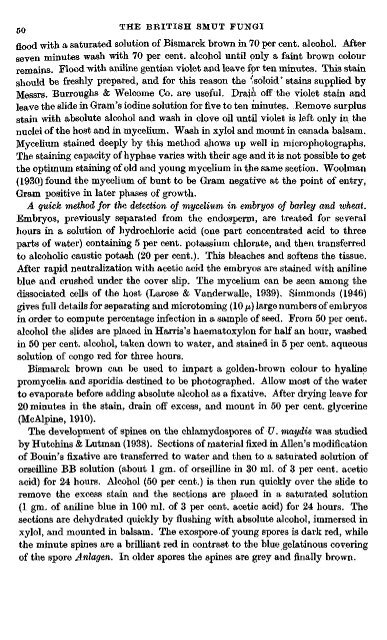nmm sP
nmm sP
nmm sP
You also want an ePaper? Increase the reach of your titles
YUMPU automatically turns print PDFs into web optimized ePapers that Google loves.
gQ THE BRITISH SMUT FUNGI<br />
flood with a saturated solution of Bismarck brown in 70 per cent, alcohol. After<br />
seven minutes wash with 70 per cent, alcohol until only a faint brown colour<br />
remains. Flood with aniline gentian violet and leave fpr ten minutes. This stain<br />
should be freshly prepared, and for this reason the Isoloid' stains supplied by<br />
Messrs. Burroughs & Welcome Co. are useful. Drain off the violet stain and<br />
leave the slide in Gram's iodine solution for five to ten minutes. Remove surplus<br />
stain with absolute alcohol and wash in clove oil until violet is left only in the<br />
nuclei of the host and in myceHum. Wash in xylol and mount in Canada balsam.<br />
Mycelium stained deeply by this method shows up well in microphotographs.<br />
The staining capacity of hyphae varies with their age and it is not possible to get<br />
the optimum staining of old and young mycelium in the same section. Woolman<br />
(1930) found the mycelium of bunt to be Gram negative at the point of entry,<br />
Gram positive in later phases of growth.<br />
A quick method for the detection of mycelium in embryos of barley and wheat.<br />
Embryos, previously separated from the endosperm, are treated for several<br />
hours in a solution of hydrochloric acid (one part concentrated acid to three<br />
parts of water) containing 5 per cent, potassium chlorate, and then transferred<br />
to alcoholic caustic potash (20 per cent.). This bleaches and softens the tissue.<br />
After rapid neutrahzation with acetic acid the embryos are stained with aniline<br />
blue and crushed under the cover sHp. The myceHum can be seen among the<br />
dissociated cells of the host (Larose & Vanderwalle, 1939). Simmonds (1946)<br />
gives full details for separating and microtoming (10 [i) large numbers of embryos<br />
in order to compute percentage infection in a sample of seed. From 50 per cent,<br />
alcohol the slides are placed in Harris's haematoxylon for half an hour, washed<br />
in 50 per cent, alcohol, taken down to water, and stained in 5 per cent, aqueous<br />
solution of Congo red for three hours.<br />
Bismarck brown can be used to impart a golden-brown colour to hyaline<br />
promycelia and sporidia destined to be photographed. AUow most of the water<br />
to evaporate before adding absolute alcohol as a fixative. After drying leave for<br />
20 minutes in the stain, drain off excess, and mount in 50 per cent, glycerine<br />
(McAlpine, 1910).<br />
The development of spines on the chlamydospores of U. maydis was studied<br />
by Hutchins & Lutman (1938). Sections of material fixed in Allen's modification<br />
of Bouin's fixative are transferred to water and then to a satui-ated solution of<br />
orseiUine BB solution (about 1 gm. of orseilline in 30 ml. of 3 per cent, acetic<br />
acid) for 24 hours. Alcohol (50 per cent.) is then run quickly over the shde to<br />
remove the excess stain and the sections are placed in a saturated solution<br />
(1 gm. of aniline blue in 100 ml. of 3 per cent, acetic acid) for 24 hours. The<br />
sections are dehydrated quickly by flushing with absolute alcohol, immersed in<br />
xylol, and mounted in balsam. The exospore of young spores is dark red, while<br />
the minute spines are a brilhant red in contrast to the blue gelatinous covering<br />
of the spore Anlagen. In older spores the spines are grey and finally brown.

















